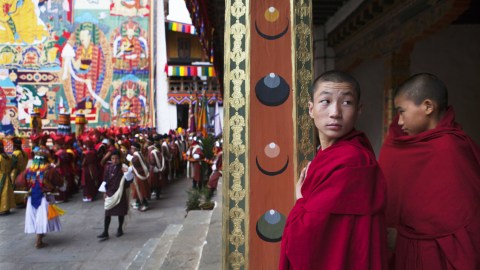4 lessons from Bhutan on the pursuit of happiness above GDP

Paula Bronstein/Getty Images
Waking to the sound of monks chanting prayers and drumming their gongs during countless traditional pujas, a ceremony of honour, worship and devotion; running up the steep Himalayan mountain slopes under colourful prayer flags hung between trees in the lush natural landscape; looking out at the expanse of forests and mountains that surrounded its capital city, Thimphu.
These are the memories that remain imprinted in my memory after two years living in Bhutan – the Himalayan Kingdom best known for its concept of “Gross National Happiness” (GNH). But, what is GNH and are the people of Bhutan really the happiest in the world?
GNH as a development philosophy in Bhutan dates back as far as 1972, when the fourth king, Jigme Singye Wangchuck, announced that Bhutan would pursue “happiness” in its path towards development, rather than measuring progress merely through growth in Gross Domestic Product (GDP). Revered in Bhutan for his many progressive actions as king, this forward-looking leader recognized that GDP did not take into account the ultimate goal of every human being: happiness.
What does the pursuit of happiness really mean?
John Lennon sums up the concept, and the tensions behind it, beautifully. He wrote: “When I was five years old, my mother always told me that happiness was the key to life. When I went to school, they asked me what I wanted to be when I grew up. I wrote down ‘happy’. They told me I didn’t understand the assignment, and I told them they didn’t understand life.”
Naturally, “happiness” is a challenging goal to understand, let alone measure. Yet, since the 1970s, much has been done to move GNH from being a development philosophy to a core component of Bhutan’s development strategy – seeking to strike a balance between GNH’s four foundational pillars: sustainable and equitable socio-economic development; conservation of the environment; preservation and promotion of culture; and good governance. A few lessons on how Bhutan, as one of the smallest economies in the world, has demonstrated leadership.
Four leadership lessons from Bhutan
1. Good Governance: In 2001, the same king who coined the concept of Gross National Happiness initiated the process of drafting a constitution that would result in the voluntary handing over of power to his people. The king emphasized that the constitution should promote and protect the present as well as the future well-being of the people and the country; ensure that Bhutan had a political system that would provide peace and stability, while strengthening Bhutan’s security and sovereignty. Despite protest from the population, who were very happy with their royal leadership, the king emphasized that it was not wise to leave such a small, vulnerable country in the hands of only one leader, chosen by birth and not by merit. The constitution led to the introduction of a parliamentary democracy, with its first elections in 2008.
2. Conservation of the environment: Bhutan’s constitution also includes unprecedented environmental measures, with such requirements as the necessity to preserve 62% of the country under forest cover at all times. Currently, it maintains a rate of about 72%. At the 2015 COP21 climate negotiations in Paris, Bhutan further announced its intention to remain carbon-neutral, ensuring that GHG emissions do not exceed the carbon sequestration capacity of its vast forests. The prime minister, Tshering Tobgay, shares his country’s ambitions to be not just carbon-neutral but carbon-negative in this recent TedTalk. Beyond these measures, Bhutan is also home to a diverse ecosystem, ranked among the top 10 countries in the world with the highest species density and recognized as a biodiversity hot-spot. It also has the highest proportion of land in protected areas, with five national parks, four wildlife sanctuaries, and a nature reserve, covering an area of 16,396.4 km squared (42.7% of the country). This list goes on.
3. Preservation and promotion of culture: Tucked between the powerful giants of China to its north, and India to the south, the fact that this tiny country remains on the map is in itself an amazing feat. Its high mountain passes and deep valleys have helped to guard the country, but have also created isolated communities which have evolved their own culture, identity and languages. Bhutan has over two dozen languages throughout the country. While celebrating this diversity with the many local tsechus, or regional festivals, at a national level, the government strives to maintain a “national identity” by requiring officials to wear traditional dress to the workplace and speak Dzonghka as the national language. The emphasis on tradition and celebration of a unique culture is part of daily life.
4. Sustainable and equitable socio-economic development: The “Gross National Happiness Commission” (essentially the government’s planning commission), has an explicit role of ensuring that all policies in the country pass a “GNH stress test” such that a balanced approach to economic development is pursued. The GNH Commission screens all government bills before they are submitted to the Cabinet using a GHN screening tool, made of up 26 variables that reflect the four core GNH principles. Based on this assessment, specific recommendations for adjustment to the policies are made.
Bhutan’s GHN approach and concrete actions have certainly raised its profile on the international stage – touted as the “last Shangri-La”, and inspiring work at the Organisation for Economic Cooperation and Development (OECD) with their Better Life Index, and even leading dialogues at the UN General Assembly on how to create a holistic sustainable development paradigm through the pursuit of happiness. But, the most important question still remains – as a result of these measures, are the people of Bhutan the happiest in the world?
For me, this is a challenging question to answer – I met many enlightened and centred individuals in Bhutan, but I also met many who struggled to merely sustain their livelihoods. What stood out however as a unique attribute of the people I met in Bhutan is the importance they place on “time” – taking time to think, time with family, time to breathe; a recognition of time and experience past by previous generations, and the importance future generational equity. This appreciation for time, reflection and the ability to pause is something that many Western cultures have lost, yet I believe forms an important part of what makes Bhutan’s GNH philosophy work in practice.
TVs, smartphones and the future
Things are however fast changing. The introduction in 1999 of the television to Bhutan has certainly complicated matters. As the people of the previously isolated Himalayan Kingdom are increasingly exposed to the luxuries and comforts around the world, a sense of desire for “more” has naturally taken hold. As I sported my old Nokia analogue phone, my taxi-driving neighbour who lived in a shack without running water or heating had taken a large portion of his savings to invest in a smartphone – increasingly seen as a sign of prestige. Individual car ownership is also an aspiration, moving away from the more traditional approach of “shared taxis”, a previously common and more environmentally sustainable approach.
Like many cultures built on subsistence agriculture, as was the case in Bhutan, a shift away from traditional agricultural practices combined with urban migration is placing pressure on the country to manage growing youth unemployment and its related challenges. While Bhutan is not a country without its struggles, what Bhutan has done to pursue a more balanced approach to economic development is not only evident on the ground, it can also serves as inspiration for countries around the world.
Antonia Gawel was working in Bhutan as an adviser to the multilateral development banks on environmental and clean energy policy.
Reprinted with permission of the World Economic Forum. Read the original article.





